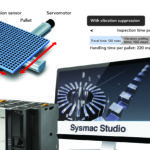In a recent Design World video, my esteemed colleague Miles Budimir and I got to assemble and zero an AMT31 commutation encoder from CUI Inc.
As we’ve covered in other editorial, capacitive technology can outperform optical technology. Used for years in digital calipers and to measure rotational movement, capacitive technology in encoders replaces optical disks with a printed circuit-board rotor containing a metal-trace sinusoidal pattern that modulates an electrical field. The receiving end of the modulated signal then passes back to a transmitter where it’s compared against the original through an ASIC. CUI’s AMT encoder series uses such capacitive technology.
Capacitive encoders advantages over common optical-based encoders include immunity to contaminants such as dirt, dust and oil; reduced sensitivity to temperature and vibration; higher reliability; and lower power draw.
Traditional installations of commutation optical encoders onto brushless dc motors is tedious and time consuming — because the optical disk must be physically and precisely rotated to align with the correct motor windings. Once aligned, the assembly must then be checked via back EMF for accuracy. This can take upwards of 15 minutes per motor.
In contrast, digital encoders allow for alignment in seconds. Case in point: The AMT31 has an ASIC and MCU so lets installers use a One Touch Zero feature and install the encoder in a few seconds. After physically mounting the encoder, energize phase 1 and phase 2 of the motor to lock the windings into place. Now align the encoder using CUI’s One Touch Zero alignment module. Turn the module on, plug it into the encoder, and check for proper communication with the encoder. Then press the alignment button — and just that easy, the encoder is aligned.
FAQ: How do digital #encoders simplify setup and zeroing? 🎯 @CUIInc Click To TweetFeaturing three-phase U, V, W commutation signals, the AMT31 series output can accommodate brushless dc motors with 2 to 20 poles, programmable via CUI’s AMT Viewpoint graphical user interface. The series also offers supplementary A, B and Z channels for servo positioning and startup sequences. 20 programmable quadrature resolutions are available with a range of 48 to 4096 PPR.
The encoder works in temperature from -40 to 105°C and has a low current draw of 10 mA at 5 Vdc — so the AMT31 series is suitable for mobile and battery-driven equipment. An input range of 4.5 to 5.5 Vdc is standard, with options for CMOS voltage or line-driver outputs. Additional options include radial or axial connector orientations, nine mating sleeves ranging from 2 mm to 8 mm, and base plates with multiple pre-drilled mounting hole patterns to mate with a wide range of motors.
Related FAQ: Why are so many designers replacing resolvers with encoders?
Thanks to its One Touch Zero module and AMT Viewpoint GUI, the AMT series simplifies control. Combined with high accuracy and simple assembly, the AMT31 works in myriad industrial, automation, robotics and renewable-energy applications.







Leave a Reply
You must be logged in to post a comment.